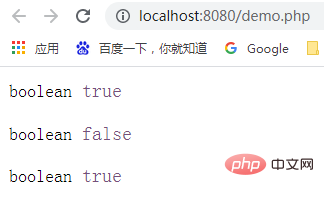php算法系列今天继续~那么在上一篇《php算法练习十:计算圆的半径和中心坐标》中给大家介绍了怎么用php计算圆的半径和中心坐标,感兴趣的朋友可以学习了解一下~
→推荐:《PHP算法练习系列大汇总(持续更新~)》
本文则给大家介绍怎么用PHP判断两个给定的整数是不是在指定范围内!
具体问题描述是“如何编写一个PHP程序来检查两个给定的整数是否在100..200范围内(包括 100..200)”?
相信大家很快就能写出来这种实现方法,下面是我给出的方法,大家可以参考一下:
立即学习“PHP免费学习笔记(深入)”;
PHP代码如下:
<?php
function test($x, $y)
{
return ($x >= 100 && $x <= 200) || ($y >= 100 && $y <= 200);
}
var_dump(test(100, 199));
var_dump(test(250, 300));
var_dump(test(105, 190));打印结果则是:

boolean true boolean false boolean true
很简单吧!在上述代码中我们就创建一个test方法,并且给其两个参数,$x, $y;
这里主要需要大家掌握的就是PHP运算符,如:
比较运算符:
大于等于(x >= y):如果 x 大于或者等于 y,则返回 true;
小于等于(x <= y) :如果 x 小于或者等于 y,则返回 true;
逻辑运算符:
与(x && y):如果 x 和 y 都为 true,则返回 true;
或(x || y):如果 x 和 y 至少有一个为 true,则返回 true。
注:return 将程序控制返还给调用模块。 将在调用模块中执行的下一句表达式中继续。
如果在一个函数中调用 return 语句,将立即结束此函数的执行并将它的参数作为函数的值返回。return 也会终止 eval() 语句或者脚本文件的执行。
最后给大家推荐最新最全面的《PHP视频教程》~快来学习吧!
以上就是PHP算法练习十一:检查两个给定整数是否在指定范围内的详细内容,更多请关注php中文网其它相关文章!

PHP怎么学习?PHP怎么入门?PHP在哪学?PHP怎么学才快?不用担心,这里为大家提供了PHP速学教程(入门到精通),有需要的小伙伴保存下载就能学习啦!

Copyright 2014-2025 https://www.php.cn/ All Rights Reserved | php.cn | 湘ICP备2023035733号